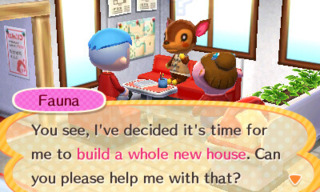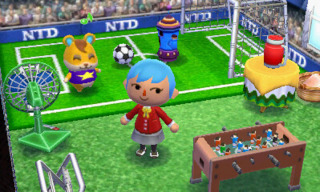Animal Crossing: Happy Home Designer does so much right: the revamped control system is the best in the series so far; it borrows the bright, imaginative design from Animal Crossing: New Leaf; and it eliminates the luck and tedium of earning some of the series' exceptionally rare items. But that's not enough to make up for the shallow, unrewarding experience.
It's important to note that Happy Home Designer is less a traditional game and more a creative canvas for laying out and designing rooms. It would be more apt to compare it to a game like Art Academy than New Leaf. Your in-game job as a home designer isn't to pay off the debt on your own abode, as is customary in the series; being a designer is just an excuse to access houses and throw around some furniture, wallpaper, and rugs.
Your initially substantial item catalog grows even larger and more unwieldy as you progress through the opening hours, but the game counters that with an excellent item search function. Typing "blue" or "chair" onto the bottom screen displays all of the items in your catalog that fit that description. It's not that Happy Home Designer does anything revolutionary; the game just utilizes the 3DS' bottom touch screen in ways New Leaf didn't even attempt. You're able to pick up and move items around at will with your stylus. A side option lets you customize the color and design of select items, and tapping each one turns them around in different directions.
At first, I lamented the fact that there's no real gameplay hook to string you along. Designing your house in Animal Crossing games is typically more of a reward rather than the sole objective. But for long-time Animal Crossing fans, it's great to finally be able to design to your heart's content. You're given access to special holiday items that in previous entries required both incredible luck and time to obtain. And the unending parade of people to design for means you have an excuse to use lots of different items.
Unfortunately, the villagers' homes have the furniture they want you to use already in the room. It's convenient, but it robs the game of some of its creative magic. If you walk up to and open the two to three boxes, then tell the resident that you're done, even if you don't add, change, or move a thing, they'll tell you you did a great job.
Despite the lack of feedback, laying out rooms is still relaxing and allows you to think creatively. But the real fun comes from designing the larger, multi-room city projects: a school, restaurants, offices, and a concert hall. With these larger-scale works, your tasks aren't laid out quite so explicitly. Instead, you might have a classroom that needs four desks and four chairs--then it's up to you to decide on those items plus whatever else you want.
I love the system's freedom, and in some ways it makes sense that you receive nothing but praise for your creations. If you could "fail" at designing a home, making new rooms would feel like a rote, unimaginative slog. If someone told you they wanted a polka dot room, and you added a chair with stripes because you thought it fit better, it would be silly to fail or to lose some meaningless points because the game classifies it as the wrong object.

But at the same time, it makes the bulk of the game feel meaningless. In Happy Home Designer, if you make a room full of stripes for polka dot-demanding villager, they'll still be happy. If you fill the room with office equipment and moldy turnips, they'll give you nothing but praise. The lack of any kind of awareness or feedback on your creations starts out off-putting and just grows more tiresome with each new design request.
When fulfilling requests, you get to decide where to place each house on a map, and you can even choose the season and weather. But like the room design itself, this doesn't have any impact on your villagers' feedback; if you want, you can place every house in the exact same location. The houses never overlap or meet, and it doesn't cancel out any previous houses you've built there. Despite creating a virtual city after a few hours with the game, you can only visit each one on an individual basis--the map is just for show, and the homes seem to exist in their own separate realities.
After you've furnished every major city building and the credits roll, the only way to continue unlocking items is by going through this same rote design system as before with new villagers. You "design" a house by opening the room's boxes and saying you're done, and you then get access to a handful of new items. You have to save the game and leave the office after finishing each project (which highlights the fact that your character doesn't seem to have a home of his own), then the next day passes, and you're back in the office again. Repeat ad nauseum.

Online, you can share individual homes you've created, but you can't invite other people into your town to show off the entire layout...not that there's much you could do together anyway. In New Leaf, bringing multiple friends into your town let you swap items, play minigames together, and interact with one another. But that camaraderie is missing entirely from Happy Home Designer, nor is there much incentive to revisit houses and talk to your imaginary neighbors. Unlike other Animal Crossing games, these aren't "your" villagers. In previous games, you needed to make sure to communicate with your town's cadre of animals if you wanted to make sure they stuck around, and they rewarded you with friendliness, giving you gifts, and even letting you customize what they said. In Happy Home Designer, after you've put dozens of villagers into new homes, no one in particular stands out or sticks around. They're just tools for getting more items.
While the initial thrill of decorating the game's big spaces is fun, I wish there was something more cohesive that tied Happy Home Designer together--a way to play with friends or an actual village that takes shape as you add more and more denizens. With what's in the game, Happy Home Designer would have been amazing DLC for New Leaf: it revamps the previous game's clunky design controls, and the glut of new items would give even hardcore fans a reason to revisit their likely neglected village. But as a standalone experience, no matter how many happy homes I design, the town just feels barren.